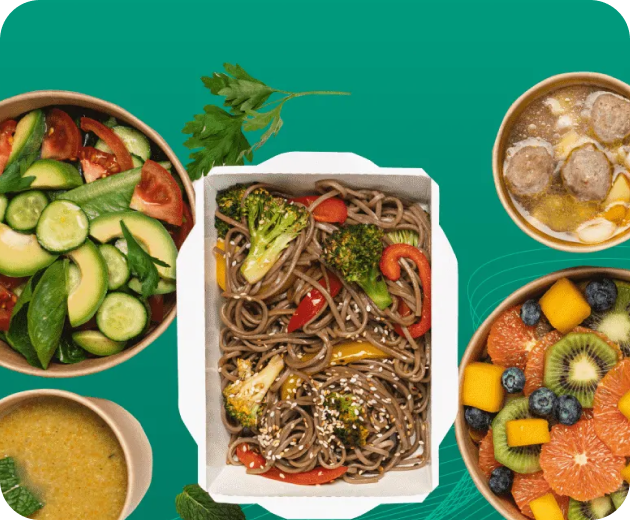The Most Successful Food Marketing Campaigns for Your Brand
In the competitive world of food, presentation isn’t enough. Industry veterans know captivating consumers requires more than a perfectly plated dish. It’s about crafting a narrative and emotional connection that translates into brand loyalty and sales. Food marketing campaigns, a multi-billion dollar business, influence consumer decisions across various channels.
According to a 2024 Statista report, measured media spending in the U.S. food, beverages, and candy sector alone amounted to a staggering 7.5 billion dollars.
This doesn’t even include the significant budgets allocated to marketing within the food service industry (restaurants, cafes, etc.).
The message is clear: understanding food marketing strategies and food marketing campaigns specifically are no longer casual pursuits; they are essential for navigating the ever-evolving landscape of the CPG and food service sectors.
What is a Food Marketing Campaign?
A food marketing campaign is a multi-faceted approach to promoting a food product or brand. It encompasses a variety of tactics, from eye-catching visuals and persuasive messaging to interactive experiences and strategic partnerships. The goal is to capture consumer attention, build brand loyalty, and ultimately, increase sales.
Effective food marketing uses consumer trends and insights to create messages that resonate with target audiences. This approach ensures the brand stays top-of-mind in a crowded marketplace, encouraging repeat purchases and fostering long-term customer relationships.
Best Food Marketing Campaigns
While every food marketing campaign is unique, some key ingredients contribute to success.
Clearly defined target audience
Understanding who you’re trying to reach is crucial. Are you targeting busy families seeking convenient meals, health-conscious millennials, or budget-minded shoppers? Tailoring your Food Marketing Campaigns through messages and visuals that resonate with their interests and needs is essential.
Chobani, a yogurt brand, heavily targets busy professionals on the go. Their food marketing strategies often feature sleek packaging, clean visuals, and messaging that emphasizes convenience and protein content, appealing to health-conscious individuals with active lifestyles.
Emotional connection
Food is more than just sustenance; it’s tied to emotions and experiences. A successful food marketing campaign taps into these emotions.
Think about the feeling of a comforting childhood meal, the excitement of trying a new cuisine, or the joy of sharing a delicious dish with loved ones.
Coca-Cola’s “Open Happiness” campaign is a prime example of this strategy. The campaign uses heartwarming visuals and uplifting music to evoke feelings of joy, togetherness, and nostalgia, associating Coca-Cola with positive emotions.
Storytelling power
People connect with stories. A food marketing campaign that weaves a narrative around the product can be incredibly effective.
This could be a story about the brand’s heritage, the sourcing of ingredients, or the inspiration behind a new product line.
The Ocean Spray Cranberries’ “Thank You Mom” campaign for a prime example of storytelling in food marketing.
Launched in 2003, the campaign tugged at heartstrings with heartwarming commercials featuring real mothers and their families enjoying glasses of cranberry juice together.
The campaign didn’t explicitly focus on the health benefits of cranberries; instead, it created a warm emotional connection between the brand, mothers, and family traditions.
This strategy resonated with consumers, propelling Ocean Spray to become a household name synonymous with family gatherings and holiday meals.
Multi-Channel approach
Consumers get bombarded with messages through various channels. A winning food marketing campaign employs a mix of traditional advertising like television commercials and print ads, alongside newer digital marketing strategies like social media engagement and influencer partnerships.
Chipotle Mexican Grill leverages a multi-channel approach. They have eye-catching television commercials featuring their fresh ingredients, a user-friendly mobile app for ordering, and an active social media presence where they engage with customers and promote healthy eating initiatives.
Best Fast Food Marketing Campaigns
Fast food marketing understands the need for speed and convenience. Here’s how they capture attention:
Limited-time offers and menu innovation
New menu items and exciting deals create a sense of urgency and encourage repeat visits. Think McDonald’s Grimace Shake or Dunkin’s Ice Spice Munchkin Drink – these campaigns capitalized on trends and pop culture references to generate buzz.
Taco Bell is known for its outrageous and sometimes bizarre menu creations. Their Doritos Locos Tacos, a limited-time offering featuring a Doritos Locos Taco shell, went viral due to its unexpected combination of flavors and textures, perfectly capturing the fast-food audience’s desire for novelty.
Value-added promotions
Fast food chains often offer bundled meals or deals that incentivize larger purchases. Think about the “happy meal” concept, where a toy is included with a children’s meal, encouraging families to choose a particular brand.
Many fast-food chains offer loyalty programs where customers earn points for their purchases, which can be redeemed for free menu items or other rewards. This strategy encourages repeat business and customer loyalty.
Appealing to the younger generation
Fast food marketing heavily targets younger demographics. Eye-catching visuals, catchy slogans, and partnerships with popular social media influencers are commonly used to connect with this tech-savvy generation.
Wendy’s, known for its sassy social media presence, often engages in playful Twitter battles with competitors and uses humor to connect with younger demographics.
They’ve also partnered with popular gaming influencers to promote their menu items to a younger audience.
Healthy Food Marketing Campaigns
The health food market thrives on promoting a positive, balanced lifestyle. Here’s how they market their products:
Transparency and education
Healthy food marketing focuses on educating consumers about the product’s benefits. Highlighting organic ingredients, nutritional value, and potential health advantages are key.
Beyond Meat, a plant-based meat substitute company, emphasizes transparency in its marketing. They showcase the ingredients used in their products and partner with health professionals to educate consumers about the benefits of plant-based alternatives.
Building trust and authenticity
Consumers are wary of empty promises. Healthy food marketing campaigns often focus on transparency in sourcing and production methods, building trust with their audience.
Whole Foods Market, a grocery chain known for its organic and natural products, highlights their commitment to ethical sourcing and sustainable practices.
They partner with local farmers and producers, showcasing the faces behind the products to build trust with their customers.
Community and inspiration
Healthy food marketing goes beyond just selling products. Many brands create communities around healthy living, offering recipes, fitness tips, and inspiring narratives to connect with their audience on a deeper level.
HelloFresh, a meal kit delivery service, offers a wealth of recipes and meal plans on its website and social media platforms.
They also feature stories from customers who have successfully used their service to achieve their health and wellness goals, fostering a sense of community and inspiring others.
What are the most effective food marketing channels for CPGs?
The answer depends on your target audience and product category. Social media platforms like Instagram and Facebook offer powerful targeting options to zero in on specific demographics and enable interactive engagement with potential customers.
Influencer marketing can also be a valuable tool. By leveraging trusted voices, you can build brand trust and reach new audiences.
Traditional media, though sometimes seen as old-fashioned, can still be highly effective. TV commercials and print ads can reach wider audiences or target specific demographics you might not reach online.
Don’t forget in-store marketing! Eye-catching packaging, strategic product placement on shelves, and point-of-sale displays can significantly influence purchase decisions at the crucial moment in the grocery aisle.
There’s no single answer. Budget allocation depends heavily on your goals, target audience, and chosen channels. However, here are some ballpark figures to give you a starting point:
- Small, targeted social media campaigns might range from $5,000 to $25,000.
- Medium-sized, multi-channel campaigns can fall between $50,000 and $250,000.
- Large-scale national TV and digital campaigns can easily reach $250,000 and beyond.
Data is your best friend! Here are some key metrics to track depending on your campaign goals:
- Brand Awareness: Track website traffic, social media engagement, and brand mentions to see if your campaign is cutting through the noise and getting noticed.
- Sales Impact: Monitor sales figures before, during, and after your campaign to assess its effectiveness in driving sales.
- Customer Engagement: Analyze website clicks, social media comments and shares, and customer service interactions to gauge how your campaign is resonating with your target audience.
Final Thoughts
Food marketing is a powerful tool that can influence our choices and shape our perception of food. By understanding the strategies behind these campaigns, we can become more mindful consumers.
The next time you’re faced with a tempting advertisement, take a moment to consider the message and the story it’s trying to tell.
After all, a truly successful food marketing campaign leaves a lasting impression, not just on your taste buds, but also on your mind.




